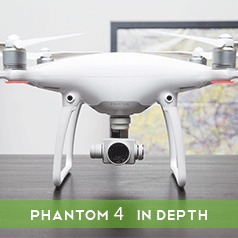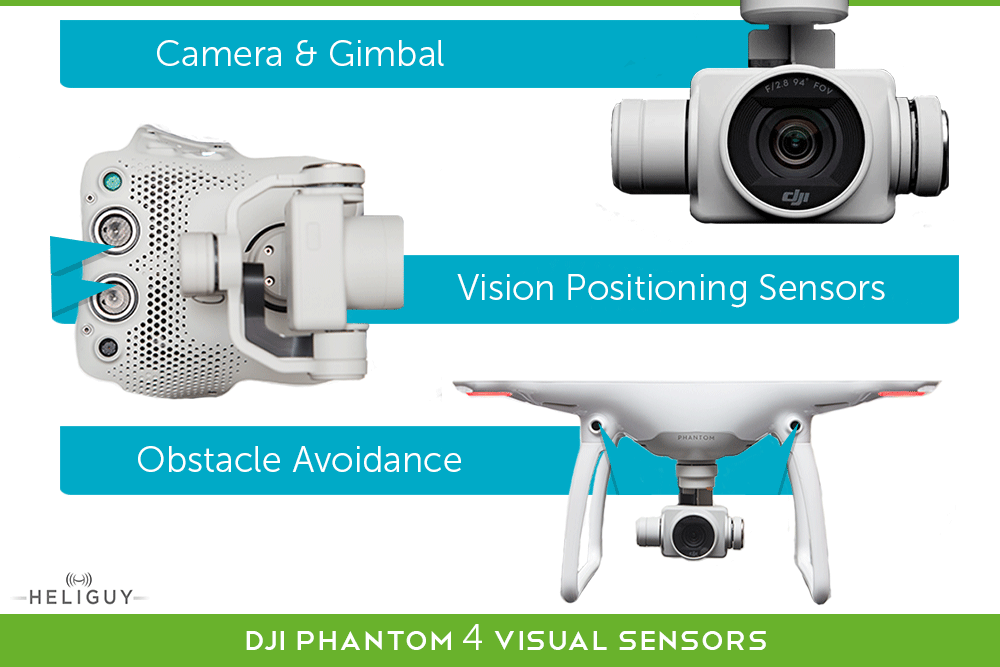
Products
Published on 12 Jul 2016
James Willoughby
DJI Phantom 4 In Depth Part 2: The Remote Controller
Part 2 of the Phantom 4 In Depth series focuses on the quadcopter's remote controller. We cover what's included, how to set it up and also offer our opinions. ... Read More
P4InDepthBannerp2.png In Part 2 of Heliguy's 'Phantom 4 In Depth' series, we're taking a look at the Phantom 4 Remote Control. Covering every step from set-up to flight, we run down the key information you need. We also asked our technicians to give their opinions and how it stacks up with DJI's other controllers.
Series Guide
Part 1 - Phantom 4 Batteries In Depth Part 2 - Phantom 4 Remote Controller In Depth Part 3 - The Best Phantom 4 Cases and Backpacks In Depth Part 4 - The Phantom 4 Camera In Depth Part 5 - The Phantom 4 Aircraft Body In Depth
The Phantom 4 remote controller provides high-quality wireless communication, integrating a video downlink together with an intuitive aircraft remote control system. Both of these features operate at 2.4GHz. The controller also includes a range of functions which give you greater control over the Phantom 4’s camera. This includes the ability to preview your photos and videos, as well as the option to take control over the gimbal’s motion. The Phantom 4's controller runs on a 2S rechargeable battery (capacity: 6000mAH). The remaining power level is displayed through easy-to-monitor LEDs indicators which are positioned at the bottom of the remote controller’s front panel ensuring that you’re never caught out by a depleted battery. P4-Controller-Diagram.png The controller has two available modes that dictate which stick operates the throttle. There’s also the option to access custom modes.
Mode 1: The right stick serves as the throttle
Mode 2: The left stick serves as the throttle
These options allow you to fly your way and cement the Phantom 4’s reputation for user friendliness.
Setting up the Phantom 4 Remote
To check your power levels when the controller is in a dormant state, press the ‘Power Button’ once. The inbuilt LED indicators will display your current battery level. When you’re ready to turn on the remote controller, hold down the ‘Power Button’. The remote controller will ‘beep’ as it powers up and the status LED will flash green, indicating that the remote is linking to the aircraft. The LED will glow solid green once the linking is complete. Simply reverse the process to shut down the remote controller after use.
Connecting a Compatible Mobile Device
Ensure that the mobile device holder is adjusted to the desired position and then press the release button on the side to loosen the clamp. Once this is done, you’ll be able to place your device into the cradle and secure it by retightening the clamp. The most common way to connect your mobile device to the remote controller is via a USB cable. To achieve this, attach the cable to both the mobile device and into the clearly marked USB port situated on the back of the Phantom 4 remote controller.
Linking the Controller to Your Aircraft
When you purchase a Phantom 4, the remote controller will be linked to your aircraft before delivery so simply turning it on will allow you to get flying straight away. However, if for whatever reason you’re using a new remote controller, follow the steps below to link it to your aircraft.
Turn on the remote controller, connect it to your mobile device and launch the DJI GO app
Power up the Phantom 4 Battery
Select ‘Camera’, press the remote controller icon, then tap the ‘Linking RC’ button
The controller is now ready to link with the Phantom 4, the status LED will flash blue and the controller will emit a tone
Press the linking button on the side of the aircraft which will begin the synchronisation; the LED will turn solid green when the controller has been linked to the aircraft
Note: Once you’re ready to take to the air, ensure that you take steps to prevent any transmission interference by not operating any more than three crafts in close airspace proximity.
Buttons, Switches and Features
All of the Phantom 4's features are available to access from the intuitive remote controller. Read on to find out what each of its components offers in terms of functionality.
Controlling the Phantom 4
This section covers how to effectively use the controller’s thumbsticks to manoeuvre the Phantom 4.

The guidelines below are based on the aircraft being in its default setting of Mode 2 (with the left stick controlling the throttle). Left Stick
Up & Down: This alters the aircraft’s elevation. When both sticks are centred, the Phantom 4 will hover in place. The more a stick is pushed away from the centre position, the faster the Phantom 4 will change elevation. Pilots should be careful to push the stick gently to prevent sudden and unexpected elevation changes.
Left & Right: This controls the Phantom 4's rudder and rotation. Push the stick left to rotate the aircraft counter-clockwise and right to rotate clockwise.
Right Stick
Up & Down: This changes the aircraft’s forward and backwards pitch. Push the stick further away from the centre position for a greater angle of pitch (max 30°) and faster flight
Left & Right: This changes the aircraft’s side to side pitch. Left strafes left, right strafes right.
Note: If you’re having any issues manipulating the thumbsticks, you may need to adjust them to suit your needs. Hold and twist the sticks clockwise or counter clockwise to adjust the length of the controller sticks. Finding the right length for your controller sticks can improve your ability to control the aircraft.
Flight Mode Switch
The Phantom 4’s controller gives you the option of three diverse flight modes which offer you the freedom to toggle the difficulty level, access to its feature-rich functionality and also how fast you want to fly. IMG_2231.jpg The purpose of each mode is described below:
Position: Gives you the ability to fully utilise the wide range of features included in this quadcopter including ActiveTrack and TapFly.
Attitude: A real test for drone pilots, a manual setting which gives you full control whilst switching off satellite positioning, perfect for low light situations where the positioning cameras are unable to see or indoor flying when GPS might be more limited.
Sport: This mode is capable of taking the Phantom 4 up to 45mph, making flying even more fun. To ensure the reliability of this thrilling setting, DJI has added an integrated gimbal and moved the battery to shift the centre of gravity close to its core. Raised motors increase torque reaction and a reliable flight control system accurately controls the aircraft’s movement to make high-speed flights safer.
Return to Home
A self-explanatory feature, pressing and holding this button will activate the Return to Home (RTH) feature. The LED ring surrounding the button will flash white to indicate that the Phantom 4 is entering RTH mode. It will then return to the last recorded ‘Home Point’. Press this button again at any time during the sequence to cancel the procedure and regain full control over your Phantom.
Camera Functions
Finally, we come to what many would consider the most important features when operating an aerial camera, the settings which enable you to capture spectacular stills and shake-free 4K footage. p4camera.png These options are available on both the top right and left-hand sides of the controller making camera control while flying an enjoyable, intuitive experience.
Camera Settings Dial (top right): Use this dial to adjust a range of settings such as shutter speed, aperture and ISO without having to let go of the controller. Toggling between these settings is as simple as pulling down on the dial.
Gimbal Dial (top left): The ability to control the tilt of the gimbal is a huge benefit to aerial photographers looking to capture that perfect shot.
Video Recording Button (top left): Pure simplicity, press this button once to start recording your footage and when you’re done, press again to stop recording.
Shutter Button (top right): Press this to capture stills and, if burst mode is activated, you’re able to choose from multiple photos taken with a single press.
Summary
With an easy-to-navigate layout, packed full of features, DJI has really complemented their impressive quadcopter with a controller that even newcomers can get to grips with. Here's what our technicians have to say about the Phantom 4's remote controller: "The Phantom 4's remote has a lot of similarities with that of the Phantom 3, however, there have been improvements such as the switch to activate Sport Mode." "This remote allows for all camera functions to be controlled: photos, starting / stopping video recordings and adjusting exposure. The tilt control wheel on the left shoulder of the remote is very simple to use, positioned where your index finger naturally lies." "Its battery life is impressive and in our experience lasts well over three and a half hours, enough time to get several flights for your craft. The Phantom 4's remote is another example that DJI have standardised their controllers across their product range, making jumping from a Phantom to, for example, a Matrice 600 an easy step to make." If you require any more information regarding the controller, the craft itself or just want to chat to a member of our team don’t hesitate to get in touch. Email info@heliguy.com Call UK: 0845 838 8652 Int: +44 (0)191 296 1024 Keep checking back to Heliguy Insider for the rest of our ‘Phantom 4 In Depth’ series and the latest drone industry news.
